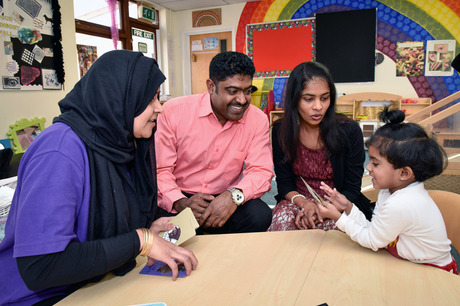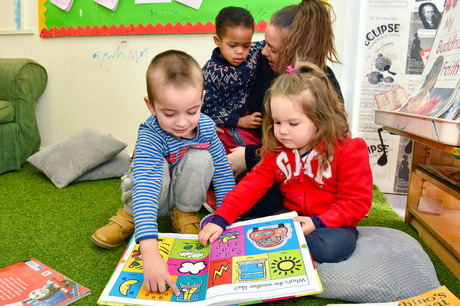
Ask most nurseries about how they overcome the language barrier with parents who speak little English, and they are surprisingly sanguine about the challenges. As one nursery manager says, ‘The aim is to settle in new children and ensure a happy time at nursery, so we just get on with it.’
It’s a barrier that settings are coming across more and more. The number of school pupils who speak a foreign language at home has risen by 20 per cent in five years, while according to latest statistics from the National Association for Language Development in the Curriculum, there are currently more than a million children between the ages of five and 16 in UK schools who speak more than 360 languages between them.
But bridging the communication gap can involve a big investment in time, often over and above the demands of day-to-day practice. Building relationships with families whose English is minimal demands thoughtful staff.
‘Many things may not be clear to the parent, so staff need to anticipate where there may be uncertainties and questions,’ says nursery manager Leela Sivaloganathan-Jones of Little Angels nursery in Cobham, Surrey. ‘Ultimately it takes longer to build a relationship [than with an English-speaking parent], because there are not the cues you would normally expect.’
Funding support for adult English classes has steadily declined, culminating in a funding cut of £45m in August 2015. The National Association for Teaching English and Community Languages to Adults says the cuts have led to a 42 per cent drop in the number of migrant adults able to take English courses. Some funding was reallocated at the beginning of this year, when the Prime Minister pledged to give an additional £20m in funding for adult English classes, specifically to target the 190,000 Muslim women in England who speak little or no English.
This leaves settings with a greater responsibility to be of practical assistance to families. Local authority support in terms of translation services and resources, such as posters and leaflets, varies from county to county. Providers report that services work well where children’s centres are still active.
At Little Angels, a set-up and pack-away nursery operating from a village hall, English is not the first language for 11 out of 50 children, who among them speak Albanian, Polish, Spanish, Portuguese, Arabic, Tamil and Finnish. Ms Sivaloganathan-Jones reports that families are often signposted to the nursery from the local children’s centre outreach worker, and says Surrey County Council also provides strong support.
‘We have a wonderful multi-agency network here in Cobham, working in partnership with Surrey, SEND services, the children’s centre, outreach worker and health visitor to fully support the family,’ she says. ‘It joins up services around them, and we can support parents to access language tuition with local training providers.’ The setting’s Ofsted report has praised its ‘exemplary partnerships with the local community which means they can provide consistent, coherent care for children’.
First steps
An initial priority for all nurseries is to communicate with parents sufficiently to ensure that children can be registered and can access the free entitlement. They also have to plan ahead to ensure that parents can contribute to progress checks, including the integrated review. As this requires parents to fill in the Ages and Stages Questionnaire, the practitioner needs to work towards having an established relationship with the family, and encourage a commitment to meeting with a health visitor.
Gathering information about the free hours is relatively simple, according to Emily Budgen, SEND manager at Lime Tree Day Nurseries, a five-strong chain operating in Leicestershire.
She says, ‘We need basic information and the paperwork is not too onerous. Registration can be more difficult, because we are looking for more detail about the child’s background and health and it has to be accurate. Conducting a home visit helps with this.
‘We find writing everything down relating to paperwork works well because families are happy to use an online translator. If a parent has very little English, they will often come in with a friend or family member who does speak English.’
Encouraging both parents to attend early on also helps. At nursery group Children 1st, with 18 sites in the Midlands and South Yorkshire, operations director Julia Mason says, ‘We use staff and other parents to translate for us, and encourage both parents to come on the first visit, as often the men of the family have better English.’
While the group as a whole has invested heavily in a range of imaginative resources to assist its work with parents – including talking pens, which parents can use to record words in their own language for children, voice recorders, dual-language books and interactive boards supplied by Mantra Lingua – Ms Mason maintains that staff who speak other languages, and offer insights into other communities, are the most precious resource.
Ms Budgen corroborates this. ‘We have staff who speak Bengali, Kurdish, French and German, and they are able to step in when needed to help, even if it is just clarifying one particular word,’ she says.
Rewarding relationships
Developing successful relationships with non-English-language families and seeing their children flourish can be enormously rewarding. Whatever the type or size of the setting, an emphasis on trust and one-to-one communication is vital.
Childminder Debra Woodhead took on a Lithuanian two-year-old full-time when his non-English-speaking mother, accompanied by an English-speaking friend, arrived at her setting in Gainsborough, Lincolnshire, in 2014.
‘The first few weeks were very hard,’ she says. ‘I asked mum to give me Lithuanian words so I could create labels to place around my house, but she was adamant that he needed English, not his home language. He kept repeating words that we didn’t understand, although we eventually worked out through Google translate that he was saying “Is mummy coming soon?”.’
To start the ball rolling, the setting purchased tiny picture frames that held pictures of the children, of Ms Woodhead, and of other childminders she works with, as well as familiar places, such as a local children’s group and a childminder’s car.
These were displayed around her home and would be pointed at with the corresponding word or name spoken aloud to identify people and places that would feature during the day.
Another useful idea was adding his mother on Facebook. ‘This means we can point to people in his family in front of him and find out their names and who they are, which has been great for language development,’ Ms Woodhead says.
Over a period of about six months, she reports that the child went from staying out of the group and never removing his hat and coat to joining in with the activities.
After 18 months he is now speaking in sentences, can say how he is feeling, can ask for things and sing nursery rhymes.
Ms Woodhead expects to have a long-lasting relationship with the family. ‘I’ve also found it is a good idea to be upfront about asking mum what she means when she speaks in Lithuanian.
‘She says “I love you” in Lithuanian every time she greets me in my home,’ she adds.
CASE STUDY: BEWBUSH COMMUNITY NURSERY

Bewbush Community Nursery, in Crawley, West Sussex, has 97 children on roll, of whom 46 have English as a second language. It has a total of 28 different languages spoken in its nursery.
Director Linda Godley says, ‘We use a lot of photographs in the children’s learning journals, and in our welcome book there are photographs to cover most items as prompts. We spend a lot of time with parents at registration visits and you would be amazed at how good we have got at talking using signs, facial expressions and pointing!
‘In some cases parents will use their older children as interpreters and we make sure that the parent or carer completes the Language Spoken at Home box on the registration form. We can then prepare before the child starts with us, getting to know key phrases and words, and looking at suitable foods.
‘We are also lucky that some of our staff represent our local communities, which include Pakistan, Sri Lanka, India, Poland, Gambia, Portugal and Mauritius, and they will interpret for us. We seek help and advice from the local community on religious and cultural needs where necessary.
‘It is important that staff always listen to children’s voices, even if they cannot understand what they are saying. They all keep visual aids on them, which include our routines in the nursery, as prompts.
‘A lot of time has been spent supporting our local community of Diego Garcians who speak French or Creole, and many have volunteered in the nursery and have helped with translations.
‘When we were fundraising to upgrade our garden, an African family who had formerly attended came in to say hello and gave us a sizeable donation. That was a lovely surprise.’
FURTHER INFORMATION
National Association for Language Development in the Curriculum, www.naldic.org.uk
Advice from the Pre-school Learning Alliance, https://www.pre-school.org.uk/providers/inclusion/540/we-have-a-family-using-our-setting-who-do-not-speak-english-what-should-we-do
Advice from National Day Nurseries Association, www.ndna.org.uk/Search?SearchTerms=English%20as%20an%20additional%20language









